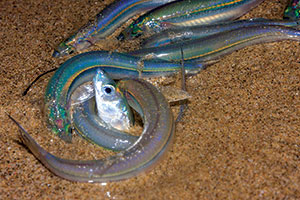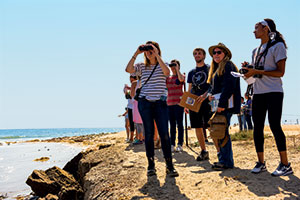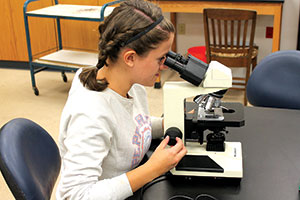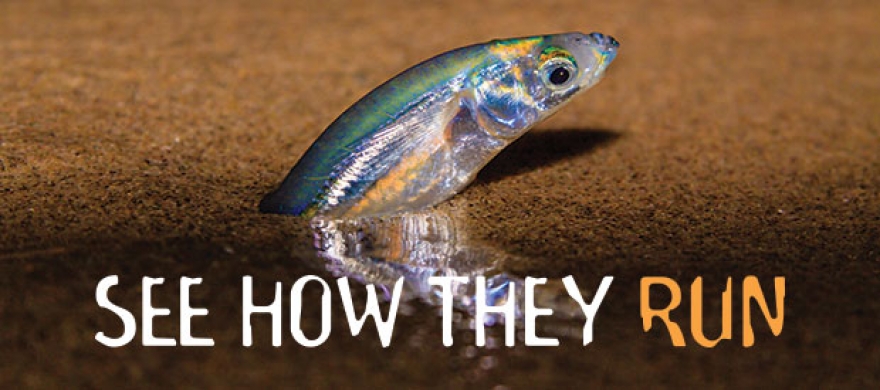See How They Run
An elusive species of fish unique to the California coast has captured the interest of Seaver College biology professor Karen Martin, her students, and the entire seaside community
Along a narrow strip of the Pacific coast, shortly after the evening's highest tide, the shoreline begins to sparkle with silvery light every spring, heralding the start of one of marine life's most spectacular phenomena.
Each year throngs of California grunion, small, sardine-size fish found only along
the southern coast of California and parts of northern Baja California, swim, or “run,”
to shore as part of their unusual spawning ritual. The annual occurrence often lasts
through summer and draws curious audiences eager to catch sight of the magnificent
fish species that has intrigued both scientists and spectators for centuries.
With each new or full moon, a small group of male grunion catches a wave onshore and,
swell-after-swell, is joined by as many as thousands of others, males and females,
that may eventually blanket the beach with their flopping, luminescent bodies. The mating “dance” lasts anywhere from a few minutes to an hour or more, when females
burrow themselves in the sand to deposit their ova, sometimes up to 3,000 at a time.
Drawn to their fascinating motion, the males wrap themselves around their mates to
fertilize the eggs and quickly return to the surf. While females make the journey
to shore only once, males return several times to repeat the process. The eggs, which
are buried inches beneath the sand, incubate for 10 to 12 days until the next high
tide washes them into the ocean to hatch.
The mating “dance” lasts anywhere from a few minutes to an hour or more, when females
burrow themselves in the sand to deposit their ova, sometimes up to 3,000 at a time.
Drawn to their fascinating motion, the males wrap themselves around their mates to
fertilize the eggs and quickly return to the surf. While females make the journey
to shore only once, males return several times to repeat the process. The eggs, which
are buried inches beneath the sand, incubate for 10 to 12 days until the next high
tide washes them into the ocean to hatch.
Seaver professor Karen Martin, the region’s best known expert on grunion, has been
studying the small and slender fish for about 20 years and first became interested
in the species while researching fish that come out of water for her doctoral dissertation.
“I hadn’t planned on looking at grunion when I first started my research as a student,”
she says. “I found it difficult, because the timing was all wrong and I couldn’t ever
find them, so it took me a while to start looking at them again.”
Grunion are famously elusive and are one of the few species of fishes that come out
of water to spawn. Because of their inability to be found when not on shore, they
are also difficult to study.
It wasn’t until Martin began teaching at Pepperdine that she revived her investigation
of the beach-spawning fish. Her research now focuses on their early development, the
grunion’s most vulnerable period of life.
Grunion eggs, explains Martin, develop on land and don’t hatch until they return to
the ocean. “Not only is that an interesting situation in itself, but also, if they
are not triggered to hatch, they can stay at the same stage of development for a long
period of time: up to two to three weeks after the time that they’re ready to hatch.
They stop developing, but stay alert and aware of their surroundings.”
The life span of the grunion is two or three years. Humans pose the greatest threat
to their short- and long-term survival. As the executive director of Grunion Greeters, Martin and colleagues first organized
a team of volunteer citizen scientists in 2002 to study the human impact on the fish’s
habitat and collect data during spawning runs that is later used for research and
management.
As the executive director of Grunion Greeters, Martin and colleagues first organized
a team of volunteer citizen scientists in 2002 to study the human impact on the fish’s
habitat and collect data during spawning runs that is later used for research and
management.
The group formed after members of the public became concerned about the way that the
beaches were being maintained in San Diego. “A local citizen noticed the way that
they were raking beaches and thought that they were probably going to cause harm to
the eggs that were buried in the sand after the grunion had run,” she recalls.
Due to their very small habitat range, and their role near the bottom of the food
chain, the grunion population faces a very real threat of depletion. “There is a lot
of activity on beaches in the summertime,” she explains. “Grunion eggs are susceptible
to the impact of driving, construction, sea walls, and the changing natural supply
of sand and natural wave action on the beaches.”
Martin’s work with Grunion Greeters was her first experience involving the public
in her research, and the first event was an unexpected success. “We were looking for
volunteers to help us watch for the grunion, but I wasn’t sure that anybody would
show up to hear about it and help us with that project,” she says. “I was very surprised
when several hundred people showed up and were very excited about helping us.”
With the aid of residents, scientists, public agencies including the California Department
of Fish and Wildlife, California State Parks, the National Marine Fisheries Service,
NOAA, and local governments, and volunteers, the results of the initial study of beach
grooming practices prompted significant change in official procedures in San Diego
and other cities throughout California.
The Grunion Greeters also make recommendations for the vehicles that patrol the beaches
and the ways the beaches are maintained that will protect the areas where grunion
nests are located.
A closed season allows the grunion to be able to reproduce without any interference
from people onshore. Hunting is prohibited during April and May. To give grunion more
of a chance to survive during the open season, restrictions on how they can be hunted
were put in place in 1927.
Currently at Pepperdine Martin, along with colleagues from UC Santa Barbara, is establishing
a citizen science program called All Ashore, an initiative that will engage students
and local volunteers in monitoring sandy beaches and examining their ecology to educate
and help the community understand the kinds of organisms that they might find there.
It will provide a comprehensive look at all the animals and plants, not only grunion,
that inhabit the sandy beaches in Southern California and partner with organizations
up and down the coast, including aquariums, environmental organizations like the Surfrider
Foundation, Heal the Bay, and Santa Barbara Channel Keepers, as well as other groups.
Martin and her colleagues are also developing a web-based questionnaire to survey
the beaches in preparation for training sessions and workshops for citizen volunteers
to collect data.
“People tend to be less aware of the ecology of beaches than they are of other marine
environments,” she explains. “They are very aware of the ecology of tide pools, or
wetlands, or kelp forests, but they don’t think about sandy beaches as an ecosystem.”
Seaver graduate Vincent Quach (‘14) is helping Martin with this program and junior
Emily Pierce, who participated in Pepperdine’s Summer Undergraduate Research in Biology
program, is taking part in researching the hatching process of the grunion to understand
how they are able to hatch so quickly. Pierce’s first experience with grunion took place during a run last summer and reinforced
her research pursuits.
Pierce’s first experience with grunion took place during a run last summer and reinforced
her research pursuits.
“It is incredible to see the natural process happening,” she says. “People will come
up and ask us what we’re doing while we’re out on the beach finding grunion eggs.”
Martin’s recently released third book, Beach-Spawning Fishes: Reproduction in an Endangered Ecosystem, takes a closer look at the similarities and differences between grunion and many
other fish species that have similar behaviors on beaches all around the world. Her
research throughout has been supported by grants and contracts from the National Science
Foundation, the National Marine Fisheries Service, SeaGrant, NOAA, the National Parks
Service, and the National Geographic Society, among others. In 2010, along with Seaver
journalism professor Michael Murrie, Martin produced Surf, Sand, and Silversides: The California Grunion, an award-winning, short educational film about California grunion that was screened
at film festivals and is available for educators.
“Like most areas of science, every question you ask about grunion leads to another
question,” she says, “so you just keep going.”
“When I first started looking at grunion, I was working with students and a very small
group of collaborators, but now I realize that we have to involve the public and the
people who work at beaches and, really, the whole community.”
Grunion photos courtesy of Dan Harding
Learn more about grunion: grunion.pepperdine.edu
Watch a video of a grunion run recorded June 16 near Malibu, California:
